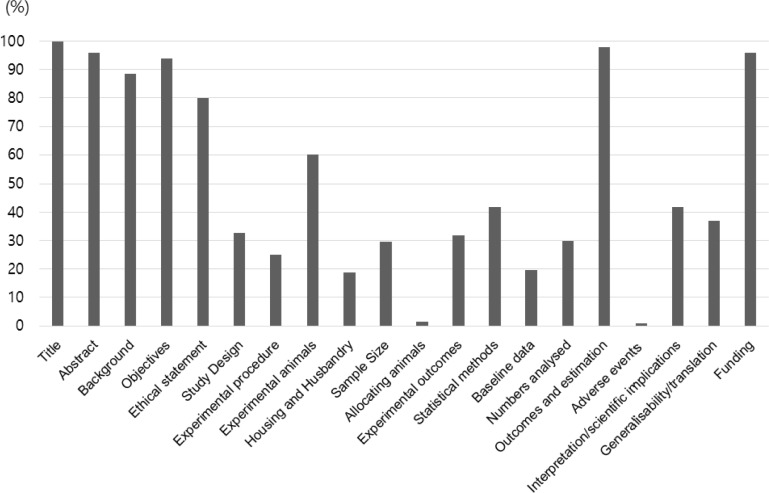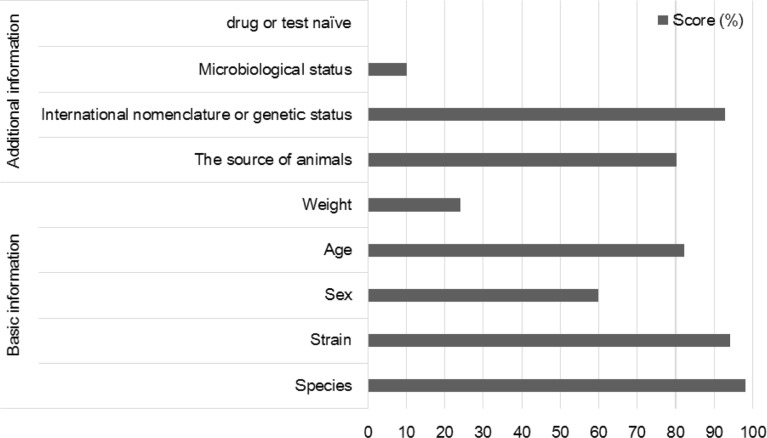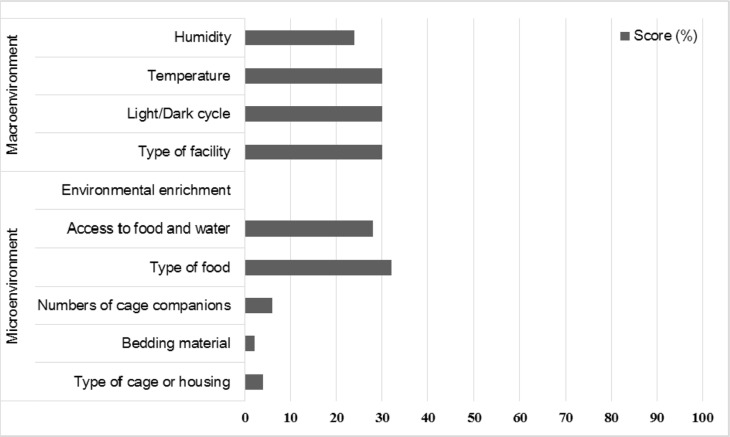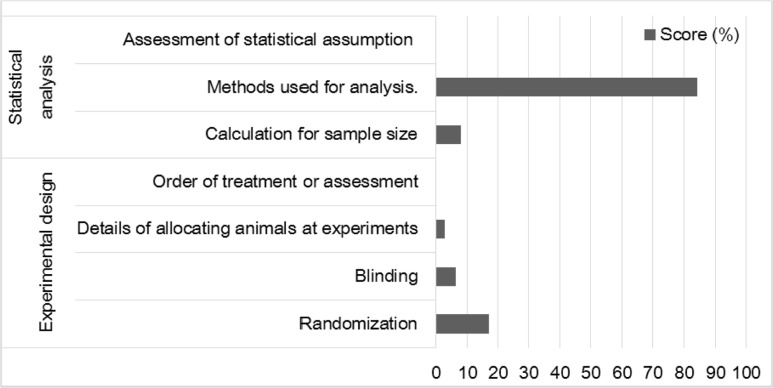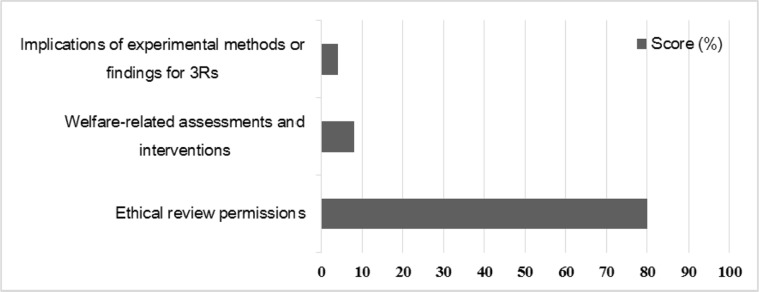Lab Anim Res.
2018 Mar;34(1):11-19. 10.5625/lar.2018.34.1.11.
Ensuring reproducibility and ethics in animal experiments reporting in Korea using the ARRIVE guideline
- Affiliations
-
- 1Laboratory of Developmental Biology and Genomics, College of Veterinary Medicine, Research Institute of Veterinary Science, and BK21 Program for Veterinary Science, Seoul National University, Seoul, Korea. snumouse@snu.ac.kr
- 2Korea Mouse Phenotyping Center (KMPC), Seoul National University, Seoul, Korea.
- 3Research Institute of Veterinary Science, College of Veterinary Medicine, Seoul National University, Seoul, Korea.
- 4College of Liberal Arts, Hongik University, Seoul, Korea. wolfkim8@gmail.com
- KMID: 2430881
- DOI: http://doi.org/10.5625/lar.2018.34.1.11
Abstract
- The aim of this study is to evaluate the reporting quality of animal experiments in Korea using the Animals in Research: Reporting In Vivo Experiments (ARRIVE) guideline developed in 2010 to overcome the reproducibility problem and to encourage compliance with replacement, refinement and reduction of animals in research (3R's principle). We reviewed 50 papers published by a Korean research group from 2013 to 2016 and scored the conformity with the 20-items ARRIVE guideline. The median conformity score was 39.50%. For more precise evaluation, the 20 items were subdivided into 57 sub-items. Among the sub-items, status of experimental animals, housing and husbandry were described under the average level. Microenvironment sub-items, such as enrichment, bedding material, cage type, number of companions, scored under 10%. Although statistical methods used for the studies were given in most publications (84%), sample size calculation and statistical assumption were rarely described. Most publications mentioned the IACUC approval, but only 8% mentioned welfare-related assessments and interventions, and only 4% mentioned any implications of experimental methods or findings for 3R. We may recommend the revision of the present IACUC proposal to collect more detailed information and improving educational program for animal researchers according to the ARRIVE guideline.
MeSH Terms
Figure
Reference
-
1. Baker M. Is there a reproducibility crisis? Nature. 2016; 533(7604):452–454. PMID: 27225100.2. Kilkenny C, Browne WJ, Cuthill IC, Emerson M, Altman DG. Improving bioscience research reporting: the ARRIVE guidelines for reporting animal research. PLoS Biol. 2010; 8(6):e1000412. PMID: 20613859.
Article3. Kilkenny C, Parsons N, Kadyszewski E, Festing MF, Cuthill IC, Fry D, Hutton J, Altman DG. Survey of the quality of experimental design, statistical analysis and reporting of research using animals. PloS one. 2009; 4(11):e7824. PMID: 19956596.
Article4. Burden N, Chapman K, Sewell F, Robinson V. Pioneering better science through the 3Rs: an introduction to the national centre for the replacement, refinement, and reduction of animals in research (NC3Rs). J Am Assoc Lab Anim Sci. 2015; 54(2):198–208. PMID: 25836967.5. Gulin JE, Rocco DM, García-Bournissen F. Quality of reporting and adherence to ARRIVE guidelines in animal studies for Chagas disease preclinical drug research: a systematic review. PLoS Negl Trop Dis. 2015; 9(11):e0004194. PMID: 26587586.
Article6. Tannenbaum J, Bennett BT. Russell and Burch's 3Rs then and now: the need for clarity in definition and purpose. J Am Assoc Lab Anim Sci. 2015; 54(2):120–132. PMID: 25836957.7. Graham ML, Prescott MJ. The multifactorial role of the 3Rs in shifting the harm-benefit analysis in animal models of disease. Eur J Pharmacol. 2015; 759:19–29. PMID: 25823812.
Article8. Liu Y, Zhao X, Mai Y, Li X, Wang J, Chen L, Mu J, Jin G, Gou H, Sun W, Feng Y. Adherence to ARRIVE guidelines in Chinese journal reports on neoplasms in animals. PloS one. 2016; 11(5):e0154657. PMID: 27182788.
Article9. Kim IY, Shin JH, Seong JK. Mouse phenogenomics, toolbox for functional annotation of human genome. BMB Rep. 2010; 43(2):79–90. PMID: 20193125.
Article10. Prattis S, Jurjus A. Spontaneous and transgenic rodent models of inflammatory bowel disease. Lab Anim Res. 2015; 31(2):47–68. PMID: 26155200.
Article11. National Research Council. Guide for the care and use of laboratory animals. National Academies Press;2010. Available from: http://www.nap.edu/catalog/12910.html.12. Bryant FB. Enhancing predictive accuracy and reproducibility in clinical evaluation research: Commentary on the special section of the Journal of Evaluation in Clinical Practice. J Eval Clin Pract. 2016; 22(6):829–834. PMID: 27870286.13. Hossenfelder S. Science needs reason to be trusted. Nat Phys. 2017; 13(4):316–317.
Article
- Full Text Links
- Actions
-
Cited
- CITED
-
- Close
- Share
- Similar articles
-
- Guidelines for planning and conducting high-quality research and testing on animals
- Ethical Guidelines for Use of Experimental Animals in Biomedical Research
- Considerations for experimental animal ethics in the research planning and evaluation process
- Enactment of Code of Medical Ethics, KMA and Its Application
- Analysis of Qualitative Research Published by Journal of Korean Academy of Fundamentals of Nursing

